A simple and easy one-click guide for identifying green caterpillars!
You must have come across some pale green or bright green wiggling creatures while taking a walk through your crops of tomato plants or in your garden where you have grown different types of green vegetables. These short and stout jiggling worms are more often than not different types of green caterpillar.
Unlike what most people believe, not all green caterpillars turn into butterflies. Some of them actually turn into moths instead. To figure out which species of green caterpillar will turn into a beautiful butterfly and which species of green caterpillars will give rise to adult moths, you will first need to identify them. You can use this general guide below to do that, but sometimes there will be exceptions, so make sure not to rely on this table too heavily.
| Moth Caterpillar | Butterfly Caterpillar |
| Usually hairy or fuzzy in appearance | Not fuzzy or hairy but may have spikes |
| Makes cocoons with silk covering | Makes smooth chrysalis with no silk covering |
| Typically buried in soil during pupation | Usually, hang from a structure during pupation |
But no matter what the fate of a green caterpillar is, they all have a plant-based diet with a voracious appetite for fruits and different types of green vegetables such as blueberry shrubs and tomato plants. Some of these green caterpillars eat a lot and are among the most serious agricultural pests that are known to men.
Not only do all green caterpillars eat alike, but they sort of look the same as well. Almost all mature caterpillars have a bluish-green, bright green or lime green body with black or yellow markings. These markings include yellow stripes as well as black and yellow dots wrapping all-around a lime green body.
Although most of the types of green caterpillars are not poisonous, venomous or dangerous at all, some of them do still possess spikes or spines which could end up giving you a nasty sting. In fact, one green caterpillar species is known to release acidic saliva out of its mouth to deactivate plant defenses. So, it is always best to identify which green caterpillar species ]you are seeing before you decide to pick it up in your hand!
Types Of Green Caterpillars
In this article, we will provide you with a comprehensive green caterpillar identification guide along with some fun facts and stunning pictures. So, let’s dive right in!
1. Hickory Horned Devil Caterpillar
When they say “looks can be deceiving,” just believe it as despite looking like an evil or a small dragon and a horrifying name, Hickory Horned Devil Caterpillars are very docile and one of the most harmless caterpillars around. If you disturb them, they will smash their bodies side to side to scare you away but that’s just it. In fact, due to their docile nature and unique looks, they are very popular among pet owners and collectors.
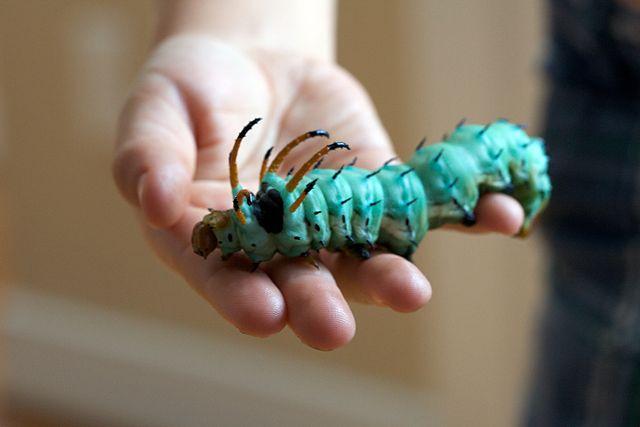
These caterpillars usually like to live on the plants of walnut, sycamore, sweetgum, hickory, ash, and persimmon. Although they feed on leaves, they are not a reason for concern as they do not cause any significant damage to the plants. They can grow as big as hot dogs, easily reaching sizes of up to 15 centimeters or more.
How To Identify A Hickory Horned Devil Caterpillar?
They vary in color but typically are bluish-green in color with black markings along the sides of the body. They can easily be identified by the large horn-like projections that are coming out from the second and third segments of their body.
2. Io Moth Caterpillar
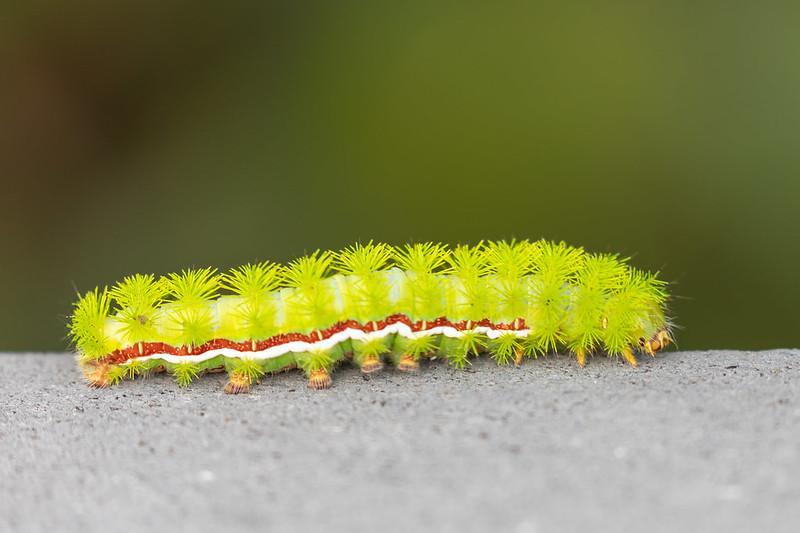
You must have heard the phrase “don’t let it get under your skin,” and after reading about the next caterpillar on our list, you will act upon it too! As evident by its look, the caterpillar has a lot of spines covering its body. But that’s not all!
There are venomous glands underneath these spines, and venom will come rushing out of them even at the slightest touch. For the unfortunate people who had the bad luck to get pierced by its spines, the pain can last for several hours, with some calling it worse than a bee sting. The caterpillar can be found gorging on the leaves of cherry, pear, oak, elm and maple to fulfill its never-ending appetite. So, next time you go around exploring these plants, keep an eye out for this little fella!
How To Identify An Io Moth Caterpillar?
Mature Io Moth Caterpillars are very light green in color with pale green tufts arising from all over the body. In addition to that, they also have red and white stripes running across the length of their bodies which you could use to identify them.
3. European Puss Moth Caterpillar
It is hard to miss a European Puss Moth Caterpillar. The caterpillar will undoubtedly stand out among the large fat green caterpillars of your ordinary garden neighborhood. This green caterpillar has a large triangular head with a long bifurcated tail on the other end. It uses its tail to scare off insects such as ants that might try to attack it. It definitely looks bizarre, and for a good reason.
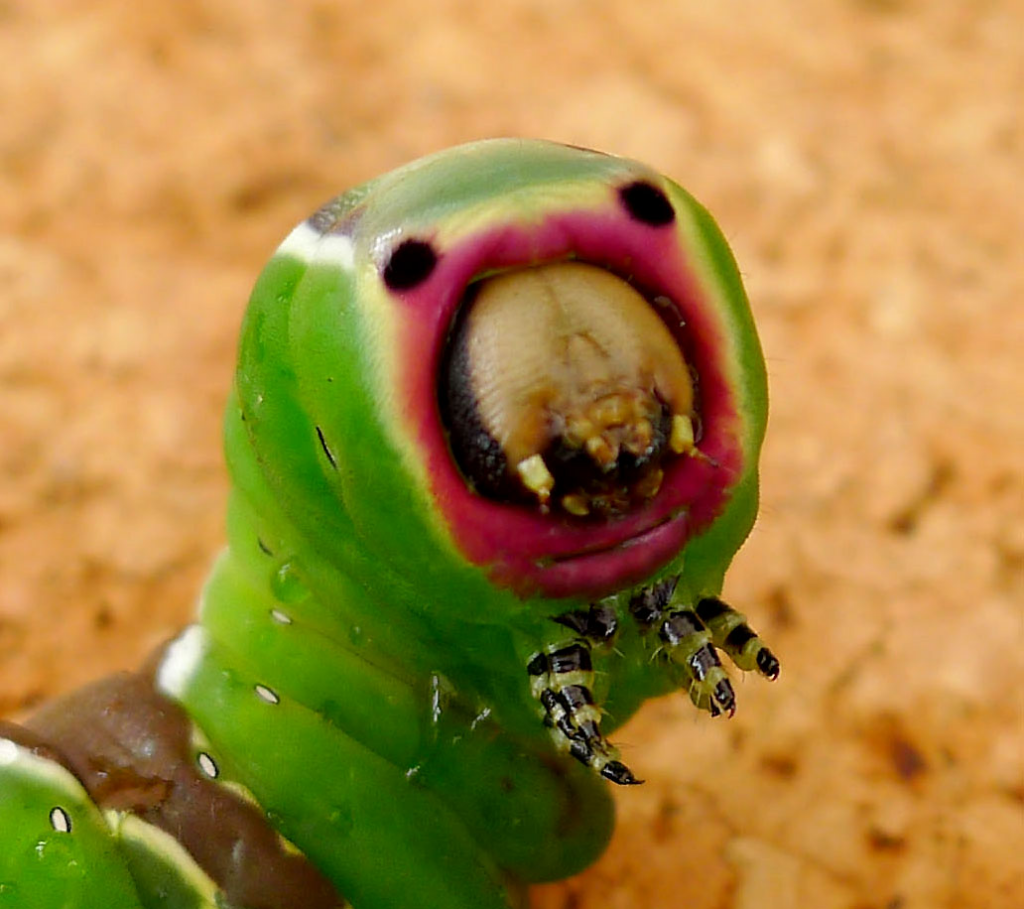
When annoyed, the European Puss Moth Caterpillar will eject formic acid through its mouth. The caterpillar usually uses its acid to defend itself against potential predators. But if you come across one, try to keep your distance and look for the signs of agitation. The European Puss Moth Caterpillar will whip its long bifurcated tail sideways and raise its head to appear more prominent when it is angry.
These caterpillars can usually be seen between July to September. They are voracious eaters and can strip entire plants of leaves in a matter of weeks. After fulfilling their enormous appetites, the caterpillars pupate and spin a cocoon. Here, the European Puss Moth Caterpillar will stay dormant for the wintertime and then emerge as an adult in the following spring.
How To Identify A European Puss Moth Caterpillar?
The European Puss Moth Caterpillar can be easily recognized by its big fluffy head and long tail. The head has a characteristic pink strip encircling the mouth. And the tail is bifurcated with red-colored tips at the end. Also, the caterpillar has orange or yellow spots on its body.
4. Luna Moth Caterpillar
Unlike most species of caterpillars which have a smooth body, Luna Moth Caterpillar has a spiky pale green body. The body is also covered in red dots which you could use to identify a Luna Moth Caterpillar in an instant. Although these spikes are not stingy, they are still very sharp and can cause irritation on contact. In addition, they emit a clicking sound when threatened. The caterpillars also have a very unique defensive mechanism against predators.
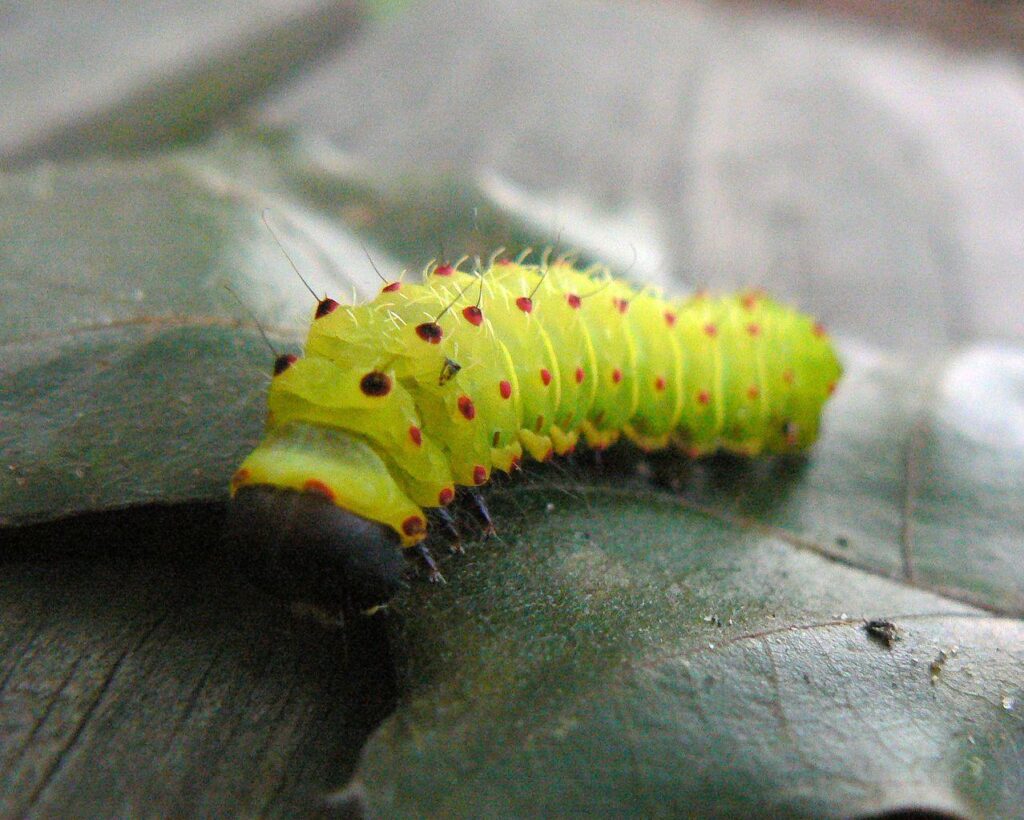
When they sense danger, they spit out the contents of their stomach which confuses the attacker and gives them enough time to escape from the scene. Luna Moth Caterpillars generally have a very varied diet. The caterpillar gives rise to a type of silk moth. It can be seen chowing on walnut, hickory and birch plants during the summer months.
Once it has fulfilled its appetite and has collected enough energy to pupate, Luna Moth Caterpillar forms a cocoon. The adult moth emerges after a while and only lives for about a week. During that one week, it mates, lays eggs and then dies.
How To Identify A Luna Moth Caterpillar?
The caterpillar is usually large, ranging in size from 7 to 9 centimeters (2.75 to 3.5 inches). Its body is pale green to yellowish with red dots all over. The body is also covered with thin spikes that sort of give it a hairy appearance.
5. Emperor Moth Caterpillar
Just like what their name suggests, These caterpillars are on the kingly size of insects and are relatively big in size when compared to other caterpillars. They have pink to red spots covering their entire body encircled by black stripes. If you observe closely, you will see a tuft of spines emerging from these spots.
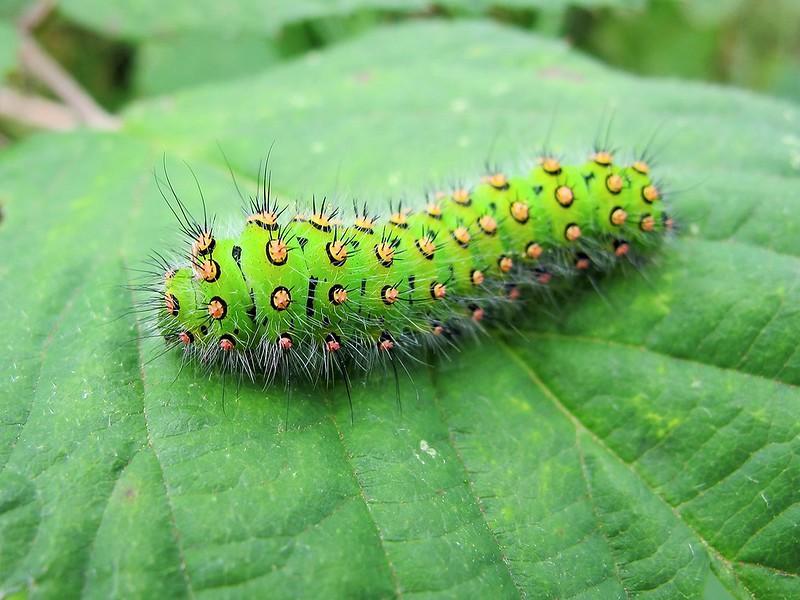
These caterpillars change their colors as their age increases. When they are immature, they are orange to black. But as they grow up, the hues of green become more dominant in their body coloration.
The caterpillars feed on various trees and shrubs including Hawthorn, Hazel, Blackthorn, Sallow and Bramble. After about six weeks of non-stop eating, the caterpillar makes a cocoon and is ready to sleep through the harsh month of winter.The cocoon serves as a shield against the insects that might try to eat the caterpillar as it sleeps. Adult moths emerge from the cocoon between April and May. The caterpillar is the only member of its family Saturniidae.
How To Identify An Emperor Moth Caterpillar?
You can easily recognize an Emperor Moth Caterpillar by the presence of red spots on its body. There must be tufts of black spines arising from these spots. These spines are not a serious threat but are pretty stiff and pointy. So, if you decide to play with an Emperor Moth Caterpillar, be sure not to get pierced by these spines.
6. Rustic Sphinx Moth Caterpillar
These caterpillars are also sometimes called hornworms. A quick look will straight away tell you where the Rustic Sphinx Caterpillar gets this nickname from. The Rustic Sphinx Caterpillar has a long horn-shaped spike at the posterior end of the body which they also use to defend themselves.
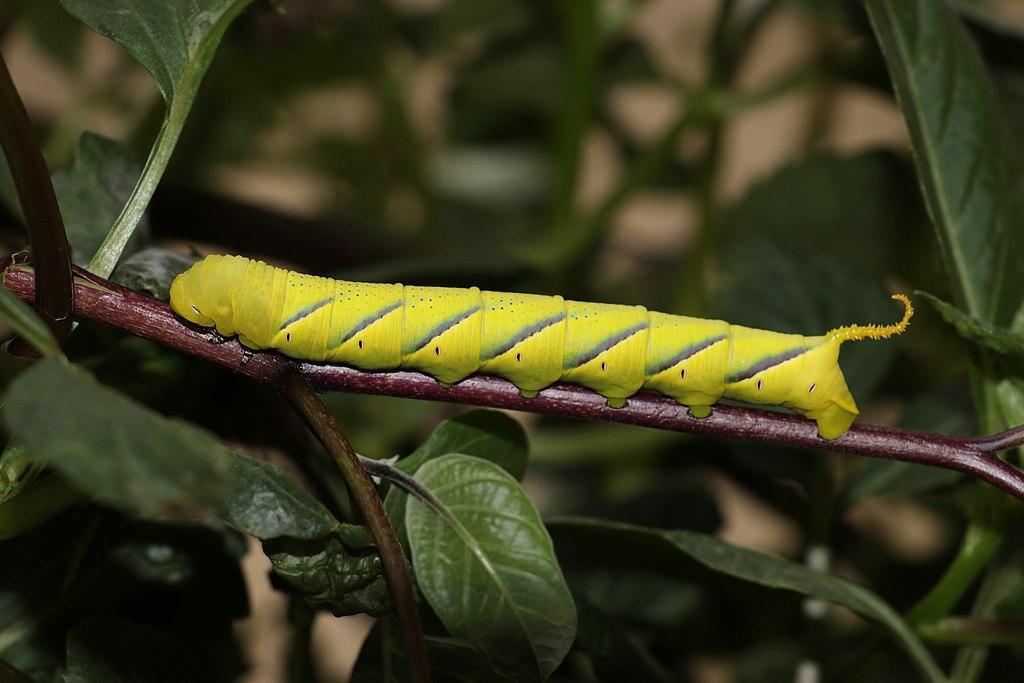
These caterpillars are generally found on cat’s claw vine, butterfly bush and desert willow plants. They are common throughout the southern parts of North America where they have been known to damage developing fruit crops. Many people often mistake them for the tobacco hornworm because of their extreme resemblance.
They get the “Sphinx” in their name from the way they like to raise their body just like the Egyptian Sphinx. The caterpillar has a pale yellow body with diagonal stripes of yellow or white across the body. At the end of its life, the caterpillar turns reddish-brown. This is thought to be an adaptation that helps the caterpillar hide among the falling leaves.
How To Identify A Rustic Sphinx Moth Caterpillar?
The caterpillar has a pale green body with diagonal yellow stripes. The stripes are bordered with colors of black or purple. At the posterior end of the body, there is a horn-shaped spike that they use to cling to leaves or other parts of plants.
7. Genista Broom Moth Caterpillar
The caterpillars are common during the late summers or early fall in areas where they are present. Usually, they are found in regions of North America including North Carolina, California, Florida and Texas.
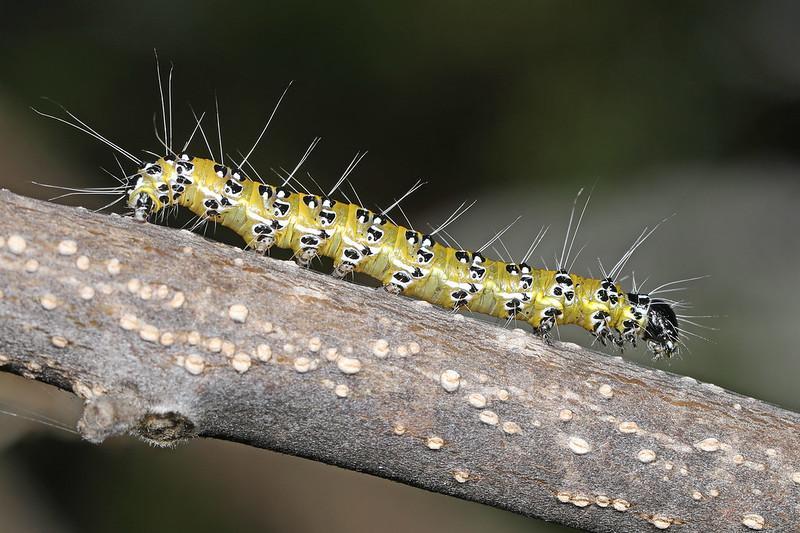
Genista Broom Moth Caterpillars are found on acacia plants, scotch broom, Lupine and false indigo and wild blue indigo. They are known to store alkaloids in their bodies, making them bitter and somewhat toxic. So, no matter how adorable they appear, do not try to put one in your mouth.
They are also called sophora worms in the areas where they are found. They usually do not affect the plants unless they are present in huge numbers, but they do form a loose webbing, causing slight damage. However, most people are okay with their presence as they can be a source of food for the local plants.
How To Identify A Genista Broom Moth Caterpillar?
Genista Broom Moth Caterpillar is a small green caterpillar species that is not actually really green. A mature Genista Broom Moth Caterpillar has a brown body with black markings on its body. They have raised black dots on each segment of the body. There is a white spot at the tip of each dot from which long white hairs arise. The head is usually black with white dots all over it.
8. Tiger Swallowtail Butterfly Caterpillar
If you are out in your garden and you see a caterpillar staring at you, it is most likely a Tiger Swallowtail Butterfly Caterpillar. These larvae have false eyes which become more prominent as they grow up. These false eyes are a way to confuse or scare off potential predators that might be trying to eat the caterpillar.
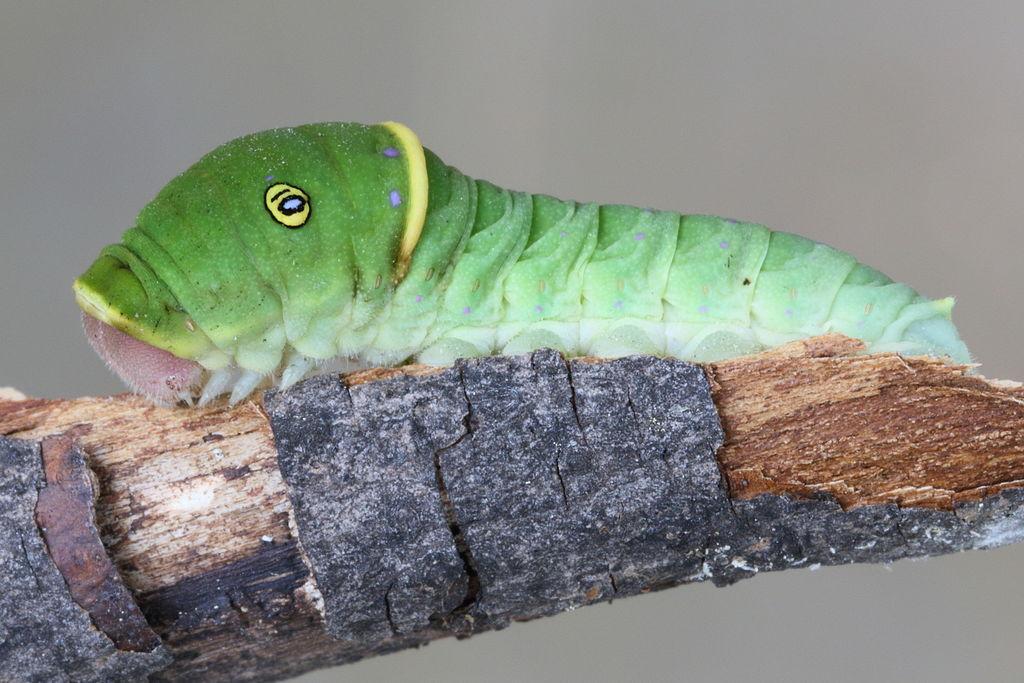
The Green Tiger Swallowtail caterpillar is green, but it becomes brown just before pupation. They are generally present on cottonwood, sweet bay, tulip tree, wild cherry and white ash. When the larva is just about to pupate, it regurgitates all its undigested food and makes a cocoon. After that, it emerges as a beautiful butterfly and feeds on plant nectar.
How To Identify A Tiger Swallowtail Butterfly Caterpillar?
Just look for a giant green caterpillar with orange and yellow spots near the head that look like eyes. Also, the caterpillar may have purple-colored dots spread all over its body.
9. Imperial Moth Caterpillar
These caterpillars are giant. Some of them can even grow to 12 centimeters or even more. When they are done munching on the soft juicy leaves, they move to the soil and dig in. They do not make any cocoons.
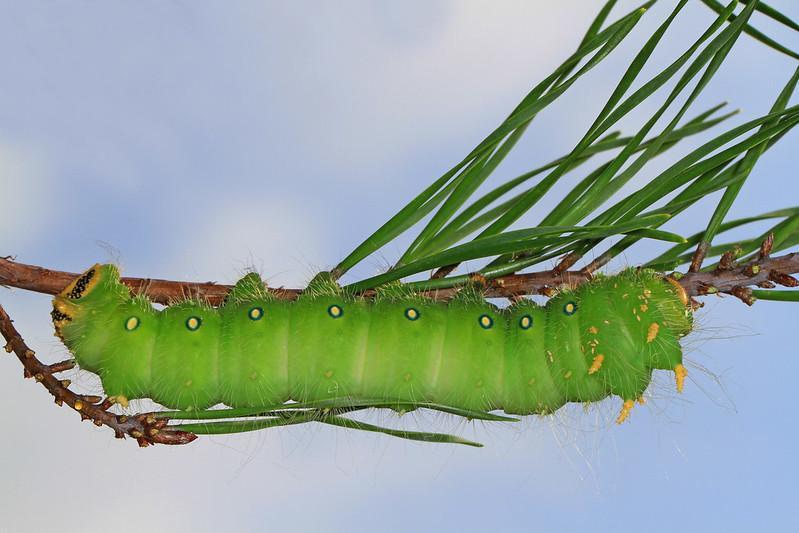
They are not very common because they often become food for the birds because of their enormous size. Mature caterpillars have a hairy appearance and these hairs can cause itching on contact. These caterpillars are usually present on oak, maple, elm, walnut, cedar, and pine. They can often be seen during the late summer months.
How To Identify An Imperial Moth Caterpillar?
It is hard to miss an Imperial Moth Caterpillar because of its colossal size. They are usually black to brown in color and have conspicuous knob-like yellow spots on their body. Adult caterpillars are also covered in numerous hairs.
10. Cecropia Moth Caterpillar
The caterpillar usually eats the leaves of elm, maple, wild cherry, plum, apple and lilac. The caterpillar eats throughout the summer and then makes a crescent-shaped cocoon that hangs from a tree branch. You will be amazed by the speed at which these caterpillars grow.

They are black and about half an inch when they emerge from eggs, but they become green and can grow as large as four inches as they grow up. Even though the caterpillar is very strange looking, it gives rise to a beautiful moth that looks like a butterfly. The emerging moth does not eat at all; its only purpose is to mate and then die.
How To Identify A Cecropia Moth Caterpillar?
The caterpillar is a fat green body with segmentation. The presence of large segments gives its body a ridged appearance. In addition, the caterpillar has yellow, blue and orange protrusions coming out of its body, ending with black spines.
11. Angle Shades Moth Caterpillar
These insects are on the smaller side as compared to other caterpillars on the list. They only reach a length of about 45 millimeters when fully grown. They can be seen all year round, mainly feeding on wild and cultivated flowers. These plants include dock, bramble and sallow.

Thanks to its small size, the angle shades caterpillar usually does not cause much damage to the crops. Also, it can serve as an essential food source for the garden wildlife. Unlike other caterpillars, they usually are very active during the winter months and pupate near the end of March.
How To Identify An Angle Shades Moth Caterpillar?
As already stated, these caterpillars are short and stout. They vary in color from green to brown and have faint stripes on each body segment. Your best chance of locating them is at night as mostly, they hide during the day and only come out at night to feed.
12. Cabbage White Butterfly Caterpillar
Before you start wondering, no, these caterpillars are not only found on cabbage plants or their flowers. In fact, they are widespread and can also be seen feeding on kale, broccoli, and cauliflower plants.
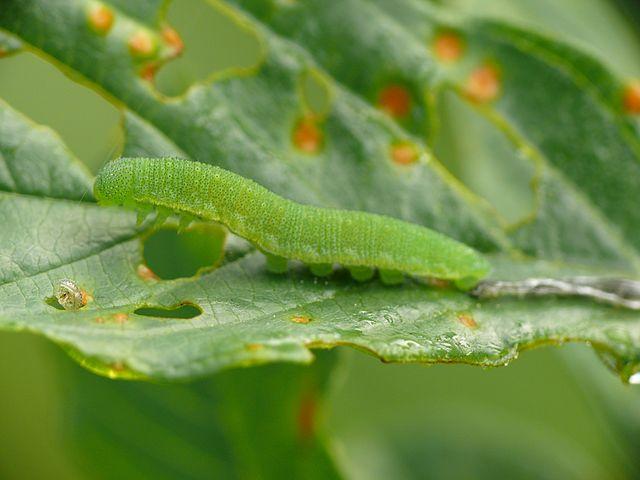
Cabbage White Butterfly Caterpillars having eaten on cabbages are full of mustard oil. This makes the pest situation even worse as predators such as birds usually leave them alone because of their bad taste. So if you see any holes in your cabbage or broccoli plants, it is most likely the Cabbage White Butterfly Caterpillar’s doing. They will rapidly eat their way through every centimeter of leaf available to them, so it is better to eradicate them as soon as possible.
How To Identify A Cabbage White Butterfly Caterpillar?
These caterpillars have a velvety appearance and a pale green color, making it hard to locate them on leaves. Make sure you check the veins of leaves where it is easy to spot them.
13. Black Swallowtail Butterfly Caterpillar
These caterpillars have a very unique defense mechanism. It ejects an orange tongue from its head when they are threatened to scare off the attacker. This is not an actual tongue but it does the job! Also, it releases a foul smell during danger which can also distract potential predators.
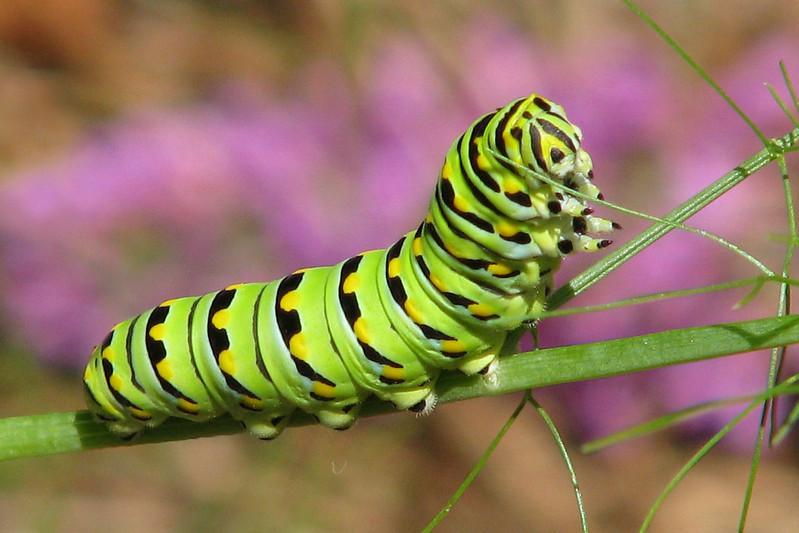
Although these caterpillars usually eat on many plants in the carrot family, they are never sufficient to cause agricultural problems. The appearance of the caterpillar keeps on changing as it grows up. You can detect their presence by locating partially eaten leaves.
How To Identify A Black Swallowtail Butterfly Caterpillar?
When they are young, these caterpillars are fully black and resemble bird droppings, and they smell like them too. We suggest keeping your distance from these caterpillars as they emit a horrible smell when approached closely. But if you are still keen on locating one, you should look for a caterpillar with a lime green body and black stripes. There are also yellow dots on these black stripes.
RELATED: Furry Caterpillar Types with An Identification Guide, Fun Facts, and Pictures
14. Copper Underwing Moth Caterpillar
These caterpillars are smart! They rapidly move to new leaves after feeding on a lead for a few seconds. This helps them escape birds that might be looking for their dinner through signs of eaten leaves to find these juicy insects.
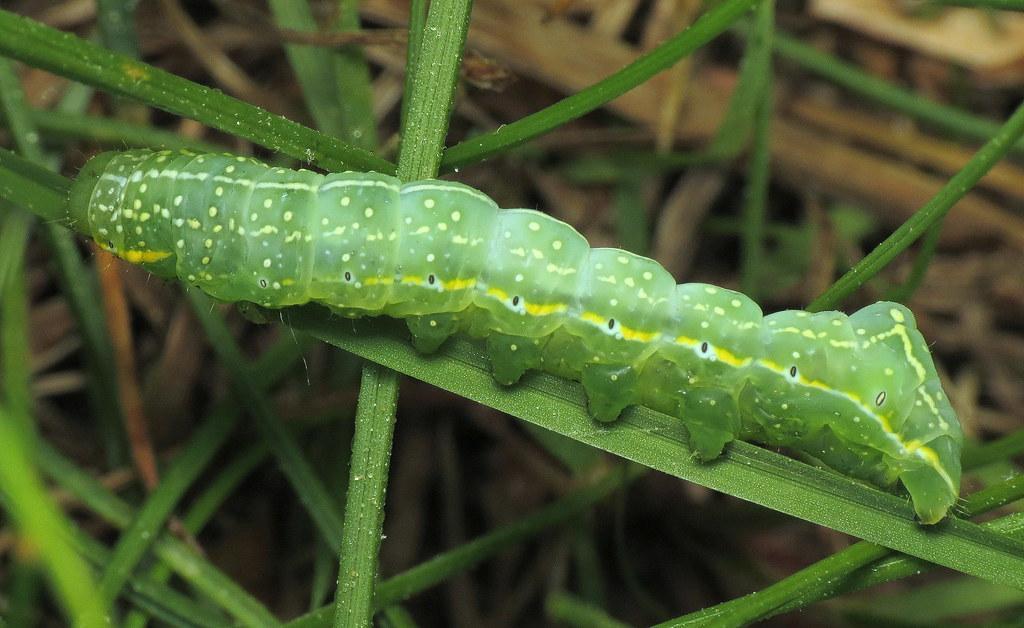
They vary in size from one and a half to two inches in length. They are not very picky about their diet and can be found machining on the leaves of many plants, including apple, maple, walnut, oak, lilac, poplar, raspberry, and basswood.
These caterpillars are usually solitary creatures residing on the underside of leaves.
How To Identify A Copper Underwing Moth Caterpillar?
They are chubby little fellas with colors of green. They sort of look like hornworms. When immature, their skin is translucent, but it becomes dark and develops yellow lines along the sides as they grow. In addition to the yellow line, small yellow dots are spread all over the body. The Copper Underwing Moth Caterpillar also has a characteristic hump near its head.
15. Winter Moth Caterpillar
They are a type of inchworm. Even though most of the inchworms are not very dangerous pests, Winter Moth Caterpillars are responsible for destroying the crops of many deciduous plants. In fact, in some cases, they have been responsible for destroying 100% of apple crops. They can reach a size of up to one inch when fully grown.
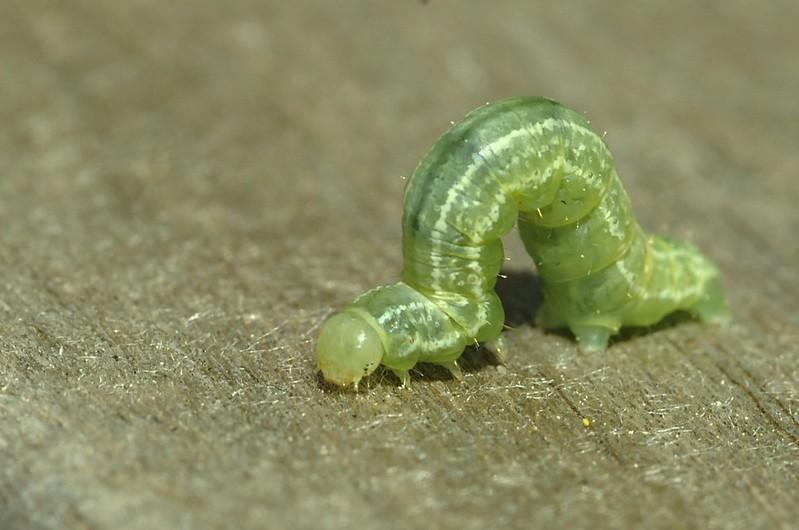
Winter Moth Caterpillars prefer to feed on cherry, ash, blueberry, apple, and basswood plants. However, they primarily feed on flowers and foliar beds and, in the process, destroy the developing fruits. Their life cycle also starts at the start of spring when flowers emerge on plants. This gives these hungry creatures a head start, multiplying very rapidly.
How To Identify A Winter Moth Caterpillar?
When they hatch, they are very thin and look like threads of black colors. But as they grow up, they start getting thicker, and their color also changes to pale green. Finally, at maturity, they also have pale white strips that run along the length of their body.
16. Tomato Hornworm Caterpillar
As their names suggest, the tomato hornworm caterpillar is very fond of feeding on tomato plants. Primarily, tomato hornworms feed on the leaves of the plant, but occasionally they might also gorge on fruit as well. Besides tomato plants, they also feed on pepper, eggplant and potatoes.

Tomato hornworms are serious pests that can defoliate entire fields. Sometimes, they can also chew holes into the developing fruits. They are pretty common in most regions of the United States and southern Canada. Because of their color, they blend pretty easily with the plants and are hard to spot. However, you can detect their presence by observing for eaten leaves and black droppings around the field.
How To Identify A Tomato Hornworm Caterpillar?
Tomato hornworms can grow as large as five inches and can easily be identified by the presence of white V-shaped markings on the green body. Also, they have a black horn-like projection on the posterior side of the body.
17. Cabbage Looper Caterpillar
Cabbage Looper Caterpillars are a type of inchworm. They get the word “looper” in their name from the moments they make while crawling on cabbage leaves during foraging. This peculiar moment comes from the arrangement of legs in a specific way. They can be found throughout the world, where crucifers are cultivated during the months of summer.
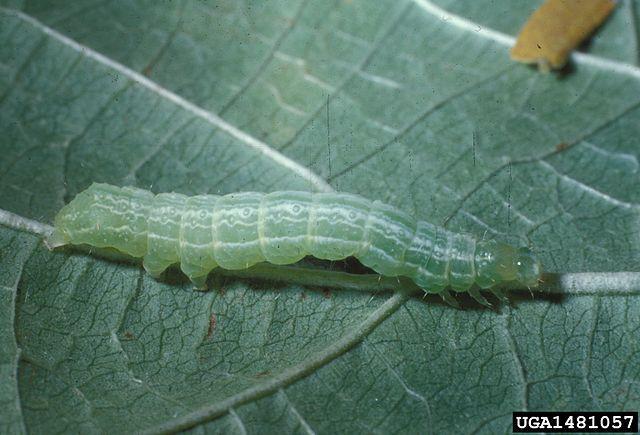
Cabbage Looper Caterpillars are a relatively predictable pest of cabbages and related plants. They cause severe damage to cultivated crops and at maturity, cabbage looper caterpillars can eat three times their weight in a single day. They are one of the most common types of caterpillars that can be found in a garden.
How To Identify A Cabbage Looper Caterpillar?
These caterpillars are pale green in color with a thin white stripe running along the sides of the body. In addition to that, there are several other thin white lines on the back. Their “looping” moment is their most distinguishing characteristic which could help you identify them.
18. White-lined Sphinx Caterpillar
The caterpillar gets the name “sphinx” in its name because of its resting position. The caterpillar sits just like the Great Sphinx of Egypt with its front parts raised in the air. This caterpillar is a type of hornworm and they are rarely considered a pest. The larva is a generalist eating on a number of plants and shrubs, but evening primrose is their favorite.
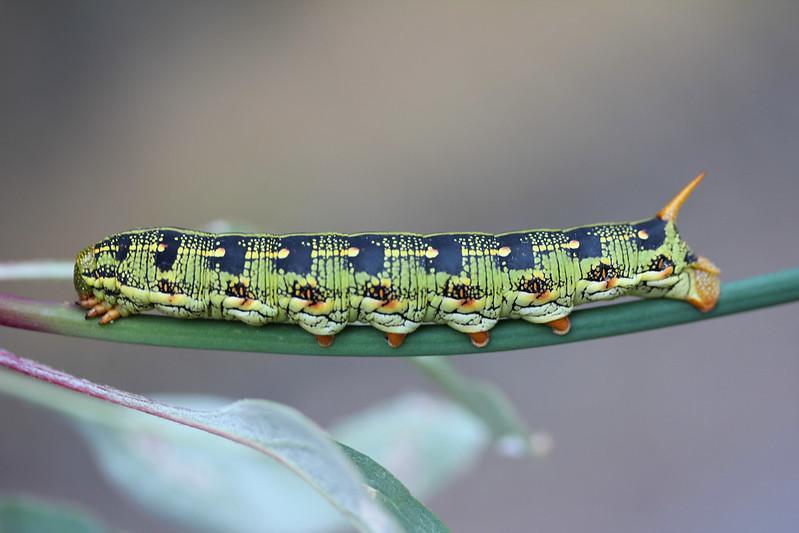
The caterpillar, despite having a horn, is not dangerous at all. In fact, it was once used as a food source by the native Americans who collected them in the day and roasted them at night.
How To Identify A White-lined Sphinx Caterpillar?
These caterpillars generally vary in color but usually, they are yellow-green to yellowish. There is a thin yellow line as well as black and yellow markings on the side. However, the most distinguishing characteristic is the presence of an orange and black horn at one end of the body.
19. Hackberry Emperor Caterpillar
As the name suggests, you will often find hackberry emperor caterpillars on hackberry trees. They usually rest on the underside of leaves. You can easily spot them by shining a flashlight on the hackberry trees during the night. The caterpillars overwinter in groups usually gathered in curled leaves.
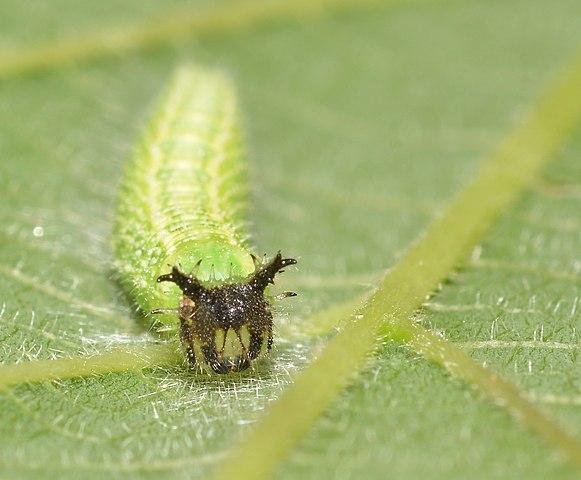
In addition to the hackberry plant, the caterpillars can also be found on sugarberry plants. During periods of rapid growth, these caterpillar larvae feed a lot and cause significant defoliation of hackberry plants. But long-term damage is often rare.
How To Identify A Hackberry Emperor Caterpillar?
Hackberry Emperor Caterpillars have a dark head with two small horns. Their body is covered with a large number of tiny yellow bumps. In addition to these yellow bumps, two thick yellow stripes are running along the back of the caterpillar.
20. Polyphemus Moth Caterpillar
These caterpillars produce clicking sounds when they are disturbed. These sounds last for about a minute to scare off the predators. The sounds are often followed by regurgitation of food which confuses the predators. These caterpillars are relatively small and vary in length from 60 to 75 millimeters. They usually live solitary life.
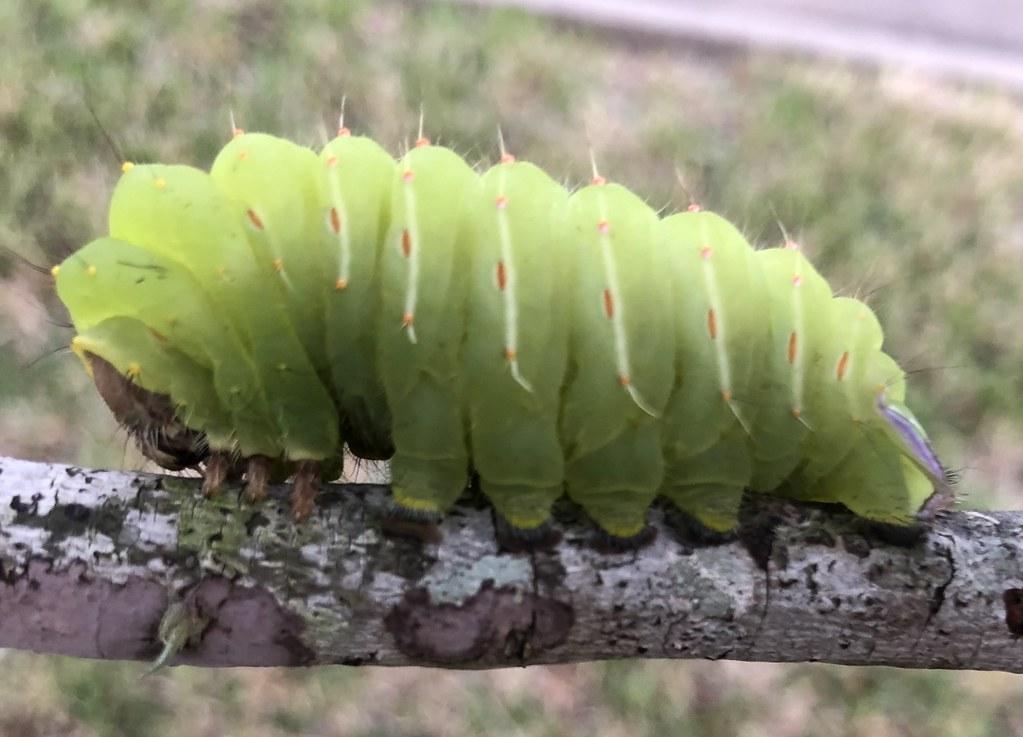
Even though they are present on several commercially important tree species, they never cause any significant damage because of their low numbers. They can be found on plants of sweetgum, birch, grape, hickory, maple, oak and willow.
RELATED: What Do Caterpillars Eat? Top 3 Host Plants You Must Know!
How To Identify A Polyphemus Moth Caterpillar?
They are often bright green and have brown heads. There is also a yellow line on each body segment which could help you to identify them quickly.
Frequently Asked Questions (FAQs)
Are Green Caterpillars Poisonous?
They are primarily non-poisonous and harmless. But some have spines that are attached to venom glands underneath the skin. These glands can release venom even at the slightest of touch. Also, some caterpillars spit acid when threatened, which could burn the skin.
Do Green Caterpillars Turn Into Butterflies Or Moths?
Unlike what some cartoons want you to believe, caterpillars do not always turn into butterflies. Some turn into moths. To figure out which green caterpillar will make a moth or a butterfly, you can check out the table below the FAQs section or at the top of the article.
Do Green Caterpillars Turn Into Butterflies Or Moths?
Unlike what some cartoons want you to believe, caterpillars do not always turn into butterflies. Some turn into moths. To figure out which green caterpillar will make a moth or a butterfly, you can check out the table below the FAQs section or at the top of the article.
What Caterpillars Should You Not Touch?
Whether moth or butterfly, most caterpillars are completely safe to touch or handle. Even some toxic ones, for example, the Monarch butterfly caterpillar, are perfectly safe to handle unless you go ahead and decide to eat it.
But, some caterpillars should never be touched. For example, ones with spikes or spines and caterpillars with bright showy colors. These spines can break off and pierce your skin and cause irritation or burning sensation which is quite painful in some cases.
Are Green Caterpillars Poisonous To Dogs?
Depending on the type of caterpillars, some might be harmful or dangerous for your dog. Although most of the caterpillars are pretty harmless, some have spines associated with venom glands. These can make your dog seriously injured or sick. Some caterpillars also feed on plants or weeds that contain compounds that might harm your dog. So, even though caterpillars are fun to watch and touch, ASPCA’s poison control center suggests that you should keep your dog away from caterpillars.
Are Green Caterpillars Safe To Touch?
Most of them are perfectly safe to handle and touch. But make sure you avoid the brightly colored ones as they can be poisonous or venomous. Also, some have sharp spines that can get you injured, so keep an eye out for that as well.
How Long Does A Caterpillar Live Before Turning Into A Butterfly?
It all depends on the species you are talking about. Nonetheless, most species of caterpillars only take a few weeks before they turn into moths or butterflies, while others may take a few months. Some butterflies can even take three or more years to complete metamorphosis, depending on the environmental conditions.
Can I Keep A Caterpillar As A Pet?
The green caterpillars often make great pets. You do not need a fancy insect terrarium to keep these creatures happy; in fact, any old fish tank or a gallon-sized jar will do. Just make sure that you provide them with plenty of their favorite food. Caterpillars eat a lot. In fact, some can eat as much as three times their body weight in a single day.
What Happens If You Eat A Green Caterpillar?
Well, it will not turn into a butterfly, We guess! You will digest just like any other food and in most cases, nothing will happen at all. In fact, you might just get some extra protein! Caterpillars are insects, and insects are full of proteins.
But as already stated, some caterpillars feed on weeds and plants that contain toxic compounds. Eating those can make you sick. Also, some have spines and bristles which could cut your tongue. So, do your research before you go ahead and start to decide to eat one of these tiny little fellas.
Why Is My Green Caterpillar Turning Brown?
If your caterpillar is light brown, it may not be getting enough food or parasites might have attacked it. In both cases, provide it with its favorite food so it recovers soon. But in case your caterpillar has turned dark brown or black, it might be dead. But do not lose hope; you can always get a new one and if you would like, keep the dead one for a few days more!
List Of Common Green Caterpillars With Identification Guide And Host Plants
| Caterpillar Name | Appearance | Host Plants |
| Hickory Horned Devil Caterpillar | Color: Blue-green Markings: Small black protrusions Size: 12 to 15 cm They can be easily identified by the presence of large horn-like structures arising from near the head. | Walnut, Butternut, Hickories, Persimmon, Sweetgum and Sumacs |
| Io Moth Caterpillar | Color: Light green or pale green Markings: Red and white longitudinal lines Size: 6 to 8 cm They have light green tufts arising from all over the body and also have red and white longitudinal lines on the sides. | Maples, Alders, Redbud, Poplars, Cottonwood, Cherries, Pear, Gooseberries, Blackberries, Willows, Basswood and elms |
| European Puss Moth Caterpillar | Color: Green with black on the back Markings: Yellow or white spots Size: 8 to 9 cm They are easily recognized by their fluffy triangular head and a large bifurcated tail with red tips. | Willow, Poplar, Aspen, Oak, Elm, Maple and Sycamore |
| Luna Moth Caterpillar | Color: Pale green to yellowish Markings: Red dots Size: 7 to 9 cm The caterpillar has a lot of spines which sort of give it a hairy appearance | White birch, Walnut, Hickory, Sumacs, Persimmon and Sweetgum |
| Emperor Moth Caterpillar | Color: Bright green Markings: Thick red spots Size: 6 to 7 cm The caterpillar has very sharp spines that arise from the thick red spots on its body. | Heather, Hawthorn, Blackthorn, Meadowsweet, Alder Buckthorn, Bramble, Sallows and Birches |
| Rustic Sphinx Moth Caterpillar | Color: Pale green Markings: Yellow stripes Size: up to 7 cm The body has diagonal yellow stripes on each segment. Also, there is a horn-shaped spike at the posterior end of the body. | Ornamental plants and olives, sesame, ash, basil, butterfly bush, crape myrtle, cross vine, desert willow etc. |
| Genista Broom Moth Caterpillar | Color: Sort of brown Markings: Black and white Size: 1.5 to 2.2 cm They have raised black spots on the body which end on white tips. From these white tips, extremely thin white spines emerge. | Acacia, Broom, Scotch Broom, Texas mountain laurel, Blue wild indigo, Lupine, honeysuckle, and many pea family plants. |
| Tiger Swallowtail Butterfly Caterpillar | Color: Dull green Markings: Fuzzy blue dots Size: up to 5.5 cm on average You can quickly identify them by looking at their swollen heads which have yellow spots that kind of look like staring eyes. | Tulip tree, Wild black cherry, Magnolia, Lilac and Joe Pye Weed |
| Imperial Moth Caterpillar | Color: Green, Brown or Black Markings: Yellow dots bordered with black line Size: up to 14 cm They have numerous hairs arising from all over the body, giving them a hairy or fuzzy appearance. | Pines, Maples, Oaks, Sweetgums and Sassafras |
| Cecropia Moth Caterpillar | Color: Light green to Yellow Markings: Blue, Yellow & Orange star-like protrusions Size: 10 to 12 cm Caterpillar’s body is highly segmented, giving it a ridged appearance. | Lilac, Elder, Ash, Sugar maple, Cherries, Plums, Apples, Birch, Dogwoods and Willows |
| Angle Shades Moth Caterpillar | Color: Green to light yellow Markings: Faint stripes Size: 4 to 5 cm Short and stout caterpillars with colors of green. | Common nettle, hop, red valerian, dock, bramble, hazel, birches, oak and barberry |
| Cabbage White Butterfly Caterpillar | Color: Pale green to dark green Markings: Yellow longitudinal lines on the body Size: 4 to 5 cm They have a velvety green appearance with longitudinal lines on the body. Sometimes they can also be brown in color. | Mustard, Cauliflower, Broccoli and obviously, Cabbages! |
| Black Swallowtail Butterfly Caterpillar | Color: Light green Markings: Thick black horizontal stripes with yellow dots Size: 6 to 10 cm Lime green smelly caterpillars with black stripes on the body which have small yellow spots inside. | Carrots, Dill, Parsley, Fennel, Turnips, and Queen Anne’s lace |
| Copper Underwing Moth Caterpillar | Color: Variations of green Markings: Yellow dots Size: up to 4.5 cm The caterpillar is plump and green in color with yellow dots all over the body. There is also a longitudinal yellow stripe on the sides with black dots. | Apple, Blueberry, Cherry, Basswood, Hawthorn, Hickory, Grape, Greenbrier, Lilac, Maple, Oak, Willow, Walnut, Viburnum and Raspberry |
| Winter Moth Caterpillar | Color: Pale green to brown Markings: White or yellow stripes Size: 2 to 3 cm Small caterpillars with pale green bodies | Cherry, Basswood, Ash, Oak, Maple, Apple, Blueberry, Crabapple and White elm |
| Tomato Hornworm Caterpillar | Color: Green Markings: White V-shaped markings on the side Size: 8 to 11 cm They grow very large and fat and can be easily identified by the presence of V-shaped markings on the side of the body. In addition, a black-horn-like structure is also present on the posterior side of the body. | Mostly tomato and tobacco plants, but they also feed on peppers, Potato and eggplants. |
| Cabbage Looper Caterpillar | Color: Green Markings: Stripes of white or yellow color Size: 3.8 to 5 inches The easiest way to identify them is by their looping moments. | Beet, Pea, Celery, Lettuce, Spinach, Potato, Cotton, Tomato, Tobacco and Soybean |
| White-lined Sphinx Caterpillar | Color: Dark greenMarkings: Black spotsSize: up to 9 cmThey have a thin yellow line crossing through the black spots on the sides. There is also a horn-like protrusion on the body. | Wild grape, Purslane, Portulaca, Tomato, Willow-weed, Apple, Wishbone plant, Primrose and four-o’clock |
| Hackberry Emperor Caterpillar | Color: Yellow-green to Green Markings: Yellow dots Size: 3 to 3.5 cm Two small horns in the head could help to identify these caterpillars easily. | Mostly hackberry trees and sometimes sugarberries. |
| Polyphemus Moth Caterpillar | Color: Bright green Markings: Yellow stripes Size: about 7 cm Their brown head can be used to identify them. | Apple, Ash, Birch, Hazle, Hickory, Maple, Rose, Dogwood, Elm and Willow |
Sources For Further Reading
- Insect pests of vegetables | Agriculture and Food. (2022). Retrieved 7 March 2022, from https://www.agric.wa.gov.au/pest-insects/insect-pests-vegetables
- Controlling Caterpillars in Vegetable Gardens. Retrieved 7 March 2022, from https://chatham.ces.ncsu.edu/2014/09/controlling-caterpillars-in-vegetable-gardens-2/#:~:text=One%20of%20the%20simplest%20methods,crops%20with%20insect%20barrier%20fabrics.
- Caterpillars and adults: Lepidoptera of the pacific northwest. Retrieved 7 March 2022, from https://www.fs.fed.us/foresthealth/technology/pdfs/FHTET_03_11.pdf
Aside from green caterpillars, learn more about different plant bugs by reading our other articles:
Editor’s Recommendations
Potato Bug 101: Potato bug bites! And everything else that you’d like to know!
How to Effectively Manage the Grapevine Beetles?
How to Kill Mealybugs on Plants With Organic and Inorganic Methods?







